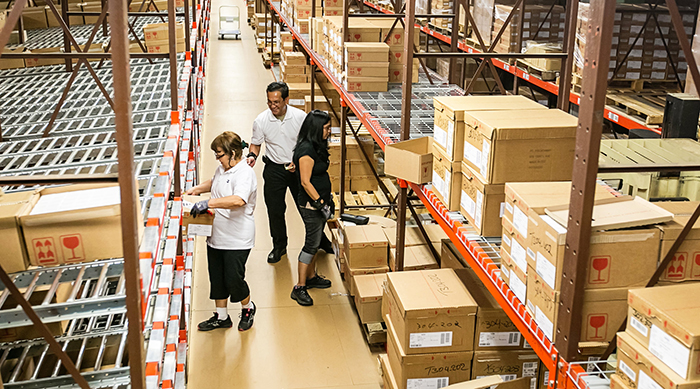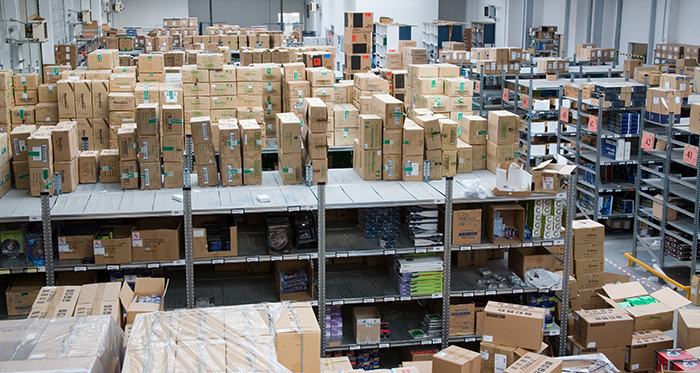Putaway is Critical for Distribution Success
Picking and packing get all the glory, but broken putaway and receiving processes affects everything else

Above: workers in a distribution center putaway aisle with flow and bulk storage accessibility. Picking aisles are left clear as the system is replenished. Photo credit: Unex Manufacturing.
Putaway, which is the methods and processes that occur between receiving inventory and that inventory resting in storage positions in a warehouse, may have more impact on the performance of order fulfillment or warehousing operation than most anything else.
Warehouses acquire inventory in different ways and from a variety of sources. An ecommerce facility may have several hundred vendors sending stock into the facility, where a dedicated manufacturing fulfillment center may only have one. This makes the process more complicated for many omnichannel distribution operations that have multiple suppliers than for direct-from-manufacturing companies, but both types of operations have challenges.
Putaway tends to be executed on racks, shelves and carton flow, but can also be done with stacked pallets, containers, storage rooms or other methods.
What does putaway affect? Most everything
If your putaway system isn’t aligned with order fulfillment needs, you may cause serious picking delays or inefficiencies. If people have to travel to find stock, or they must wait on it to be transported from bulk storage to picking positions, both throughput and quality are undermined.
Optimized storage, organization and space utilization
Good putaway processes help you organize better from the very beginning. You can consolidate new SKUs with your existing stock faster and easier because you’ll have designated slots from the very beginning. You can also pre-plan cube utilization and product slotting within the putaway process, meaning that if you have projections for any particular product, you can slot it into picking zones that are suitable to its demand.
Your putaway process should also take storage media into account — bulk items in shelves, each-picks in flow storage, pallets in flow racks, etc. This helps you match your cube and pick methods with the product and the layout of your facility. Good systems help you sequence putaway so that it takes less time and delivers products efficiently to their destinations. A thorough process helps you avoid over-burdening one area while others are relatively underutilized.
Putaway should simplify training and employee development
In today’s difficult labor market, training is always an issue. You don’t want needlessly complex systems that require longer training periods. Ideally, a new warehouse employee is productive his or her first week, and sooner if possible.
More: In a fluid workforce, worker productivity hinges on simplicity and rigid processes
Order fulfillment time should be reduced with good putaway processes

Above: busy warehouse storage area with industrial shelving, floor storage and overhead bulk storage. How does the product arrive at these storage positions in an efficient manner? How is it replenished and tracked?
Most warehouses consider the cycle time between order placement and order fulfillment a critical metric. Eliminating wasted motion, walking and energy is all on the table when your putaway process is well-defined. Storage locations are the start of the process, so when picking stock and bulk inventory are easily available, orders flow faster and with fewer interruptions.
Optimized putaway strategies help you slot dynamically and revise slotting to respond to changing order patterns or seasonal spikes. The bottom line: when you can replenish faster, you can pick and ship faster.
It’s all about reducing wasted time, energy and motion
Good putaway systems and processes will help you drive faster and more accurate order picking by ensuring that inventory is quickly slotted into storage positions. Whether that’s done between shifts, overnight or simultaneously with picking, the effect is that your pickers should always have access to whatever available inventory is in your system. It’s an under-appreciated aspect of most order picking facilities, and a place where improvement can resonate throughout your entire operation.
More resources
- Order Fulfillment is the First Line of a Great Customer Experience
- Ways to Increase Order Picking Speed
- Flow Storage and Inventory Slotting
Tags: 3PL, Third Party Logistics, ecommerce
Scott Stone is Cisco-Eagle's Vice President of Marketing with 35 years of experience in material handling, warehousing and industrial operations. His work is published in multiple industry journals an websites on a variety of warehousing topics. He writes about automation, warehousing, safety, manufacturing and other areas of concern for industrial operations and those who operate them.



